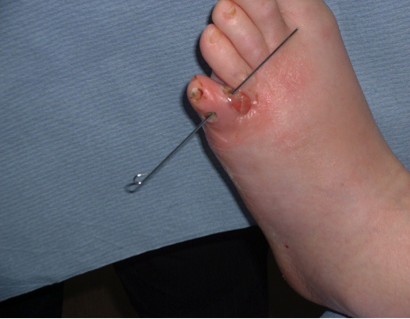
Probing ulcers
Probing any wound with evidence of sinus tract formation, tracking or undermining is important to determine the true depth, particularly in the presence of infection. The typical characteristics that should prompt clinicians to probe are the presence of rolled wound edges, if there is only a small but apparently deep opening, or when the wound appears larger under the visible wound edges. In the case of multiple adjacent ulcers, probing can also help to see if there is a tracking between the wounds.
Probing to bone may also be used as a test for osteomyelitis, although there is still much debate about the utility of this procedure as a standalone diagnostic test. In clinical practice the ability to probe bone would lead to further radiological investigations to help guide clinicians regarding the possibility of osteomyelitis. Probing should only be carried out by trained, competent healthcare professionals. Before any probing is undertaken, full debridement should have been carried out. Prior wound cleansing is also necessary to ensure that bacteria are not seeded into deeper tissues.
A blunt sterile probe should then be used and light pressure applied until resistance is felt. At that point, probing should be discontinued. If the ulcer is undermined, all areas should be probed to ensure the full extent is captured. See image below, in which the ulcer has clinical signs of infection and probes through the toe with bone involvement evident. The patient required oral antibiotics and radiological imaging to check for osteomyelitis.

Image: Sinus tract demonstrated by probing
